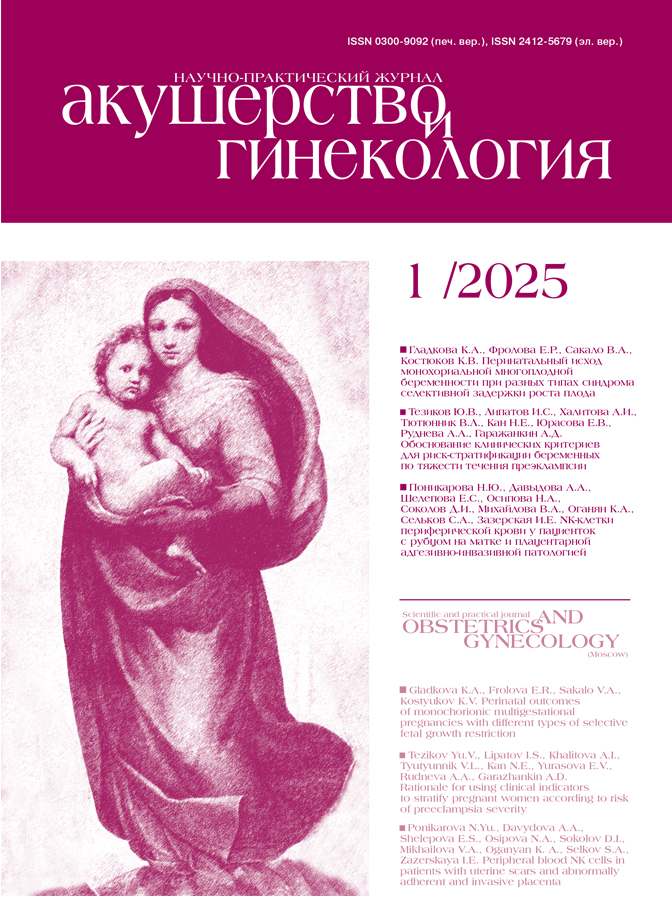Potential effect of ovarian puncture in the programmes of in vitro oocyte maturation in women with polycystic ovary syndrome
- 作者: Karimova A.U.1, Yanbarisova A.R.2, Gromenko I.I.1, Bagdanova G.M.1
-
隶属关系:
- "Family" Medical Center
- Bashkir State Medical University, Ministry of Health of Russia
- 期: 编号 1 (2025)
- 页面: 113-116
- 栏目: Exchange of Experience
- URL: https://journals.eco-vector.com/0300-9092/article/view/674642
- DOI: https://doi.org/10.18565/aig.2024.53
- ID: 674642
如何引用文章
详细
Hormonal stimulation and surgical treatment options are used to achieve ovulation in patients with polycystic ovary syndrome (PCOS). However, these methods can result in a number of complications.
Objective: To examine the possible relationship between mechanical impact on the ovary during puncture in in vitro oocyte maturation (IVM) programmes and the occurrence of ovulation in a typical form of PCOS in patients with a history of primary anovulatory infertility.
Materials and methods: The study included eight patients with androgenic phenotype of PCOS, primary anovulatory infertility and history of unsuccessful attempts of monoovulation induction and IVF.
Results: The patients were divided into two groups according to the outcomes of the IVM programmes. Group 1 (n=4) included women who had embryo developmental arrest. Three of them had spontaneous ovulation in the next cycle with subsequent pregnancy. One patient underwent repeated IVM two months after the first programme; a negative hCG result was obtained after transfer of a 3BB embryo; in the next cycle spontaneous ovulation resulted in a spontaneous pregnancy. In group 2, four patients underwent fresh embryo transfers in the IVM protocol (3BC, 2BB, 3BB, and 1B embryos) but no pregnancy occurred. In the next cycle, spontaneous ovulation resulted in uterine pregnancy in one of the patients. The other had 4BC and 3BB embryos left for cryopreservation; there were two transfers of cryopreserved embryos. The patient did not become pregnant. A repeated IVM was performed six months later. In the next cycle, spontaneous ovulation caused the spontaneous pregnancy. The pregnancy of all eight women in both groups proceeded to term, resulting in delivery.
Conclusion: The technique of mechanical ovary treatment appears to show significant potential. The extent of exposure and the potential for bleeding can be effectively managed, and the procedure itself does not result in a decline in ovarian reserve. Additionally, there is no evidence of thermal damage to the ovarian tissue.
全文:
作者简介
Aliya Karimova
"Family" Medical Center
Email: yanbarisova1999@mail.ru
ORCID iD: 0000-0001-5755-5881
obstetrician-gynecologist, reproductologist, oncologist
俄罗斯联邦, UfaAliya Yanbarisova
Bashkir State Medical University, Ministry of Health of Russia
编辑信件的主要联系方式.
Email: yanbarisova1999@mail.ru
ORCID iD: 0000-0003-3799-4080
Resident
俄罗斯联邦, UfaIuliia Gromenko
"Family" Medical Center
Email: yanbarisova1999@mail.ru
ORCID iD: 0000-0002-3373-0873
PhD, obstetrician -gynecologist, reproductologist, doctor of the highest category
俄罗斯联邦, UfaGuzal Bagdanova
"Family" Medical Center
Email: yanbarisova1999@mail.ru
ORCID iD: 0000-0001-7748-5091
Biologist
俄罗斯联邦, Ufa参考
- Джером Ф. Штраус III, Роберт Л. Барбьери, Антонио Р. Гарджуло. Репродуктивная эндокринология Йена и Джаффе. Физиология, патофизиология, клиника, диагностика и лечение. 8-е изд. Пер. с англ.; Андреева Е.Н., ред. М.: МИА; 2022. 1200 + XVI с. [Jеromе F. Strauss III, Robert L. Barbieri, Antonio R. Gargiulo. Yen & Jaffe’s Rеproduсtive Еndocrinologу. Physiology, Pathophysiology and Clinical Management. 8th ed. Moscow: MIA; 2022. 1200 + XVI p. (in Russian)].
- Rotterdam ESHRE/ASRM-Sponsored PCOS Consensus Workshop Group. Revised 2003 consensus on diagnostic criteria and long-term health risks related to polycystic ovary syndrome. Fertil. Steril. 2004; 81(1): 19-25. https:// dx.doi.org/10.1016/j.fertnstert.2003.10.004.
- Назаренко Т.А. Синдром поликистозных яичников. М.: МЕДпресс-информ; 2008. 207с. [Nazarenko T.A. Polycystic ovary syndrome. Moscow: MEDpress-inform; 2008. 207p. (in Russian)].
- Министерство здравоохранения Российской Федерации. Клинические рекомендации. Женское бесплодие. 2021. [Ministry of Health of the Russian Federation. Clinical guidelines. Female infertility. 2021. (in Russian)].
- ACOG Practice Bulletin No. 108: Polycystic ovary syndrome. Obstet. Gynecol. 2009; 114(4): 936. https://dx.doi.org/10.1097/AOG.0b013e3181bd12cb.
- Imani B., Eijkemans M.J., te Velde E.R., Habbema J.D., Fauser B.C. Predictors of patients remaining anovulatory during clomiphene citrate induction of ovulation in normogonadotropic oligoamenorrheic infertility. J. Clin. Endocrinol. Metab. 1998; 83(7): 2361-5. https://dx.doi.org/10.1210/ jcem.83.7.4919.
- Farquhar C., Brown J., Marjoribanks J. Laparoscopic drilling by diathermy or laser for ovulation induction in anovulatory polycystic ovary syndrome. Cochrane Database Syst. Rev. 2012; (6): CD001122. https:// dx.doi.org/10.1002/14651858.CD001122.pub4.
- Fernandez H., Morin-Surruca M., Torre A., Faivre E., Deffieux X., Gervaise A. Ovarian drilling for surgical treatment of polycystic ovarian syndrome: a comprehensive review. Reprod. Biomed. Online. 2011; 22(6): 556-68. https://dx.doi.org/10.1016/j.rbmo.2011.03.013.
补充文件







